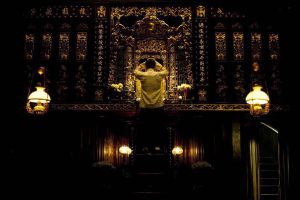
Wong Kar-wai’s films are unique in Chinese films. Generally, a film is based on the needs of the plot to portray characters, while in Wong Kar-wai’s film, the plot is based on the needs of the characters. He is good at capturing features of characters and cities (especially Hong Kong) from multiple locations, different definitions, and brightness. Architecture, an inevitable element in photography and film production, is also used flexibly and skillfully by Wong Kar-wai. For example, he asked to lower the height of the frame to highlight the height of the hero.
I asked Carman her personal idea about why architecture still plays an important role as a frame, although there are a lot other elements can do this job. “I prefer something more regional than fluent and flexible, like clothes and such kind of stuff. I would like to see a wall or a Colum more than a screen of smoke.” My question is a kind of stupid, obviously. The importance of architecture in the film is self-evident, whether as a background or as a frame for guiding the camera. Just like Carman has said, what makes architecture so unique is that it is both regional and stable.
Architecture is regional, so it representing the eternal spirit of living in a certain region, which represents a kind of horizontal national sentiment. As Abbas (1997) argued, “Architecture, because it is always assumed to be somewhere, is the first visual evidence of a city/s putative identity.”The ideal and suitable architectural design in a film adds to the realism of the story and the thick feeling of its emotions, which embodies the character image and makes the film works perfectly.
Besides, unlike those moving elements, architecture is calm and objective. This kind of stability shows longitudinal historical complex. Having witnessed the development of the city for decades, it serves as a historical narrative, a creation of the atmosphere, and a unique kind of aesthetic.
From both horizontal and longitudinal aspects, architecture plays an irreplaceable role in the narrative of a film. It introduces the historical background of the story and awakes the cultural genes in every audience’ heart.
by Li Wanze (3035535121)